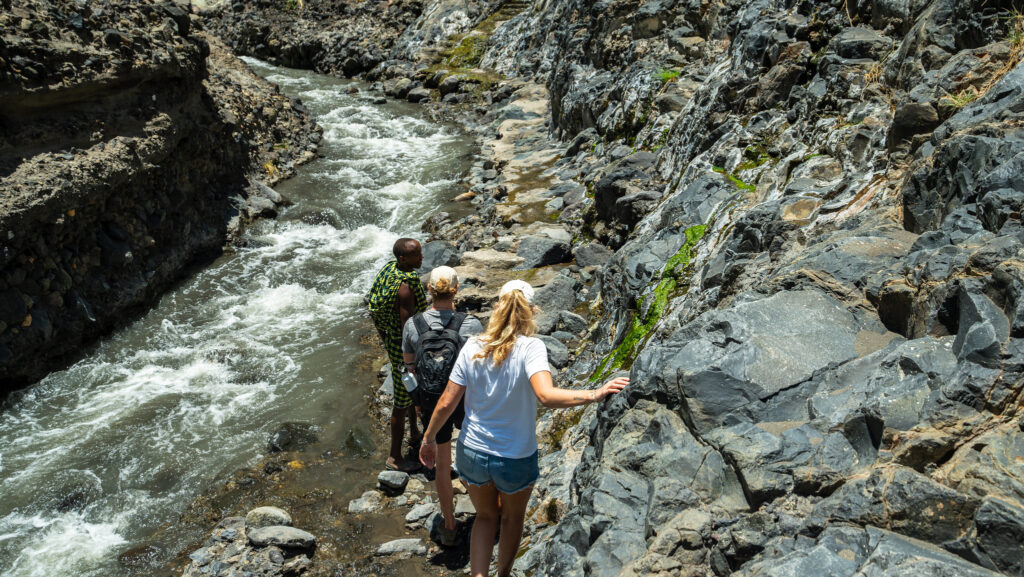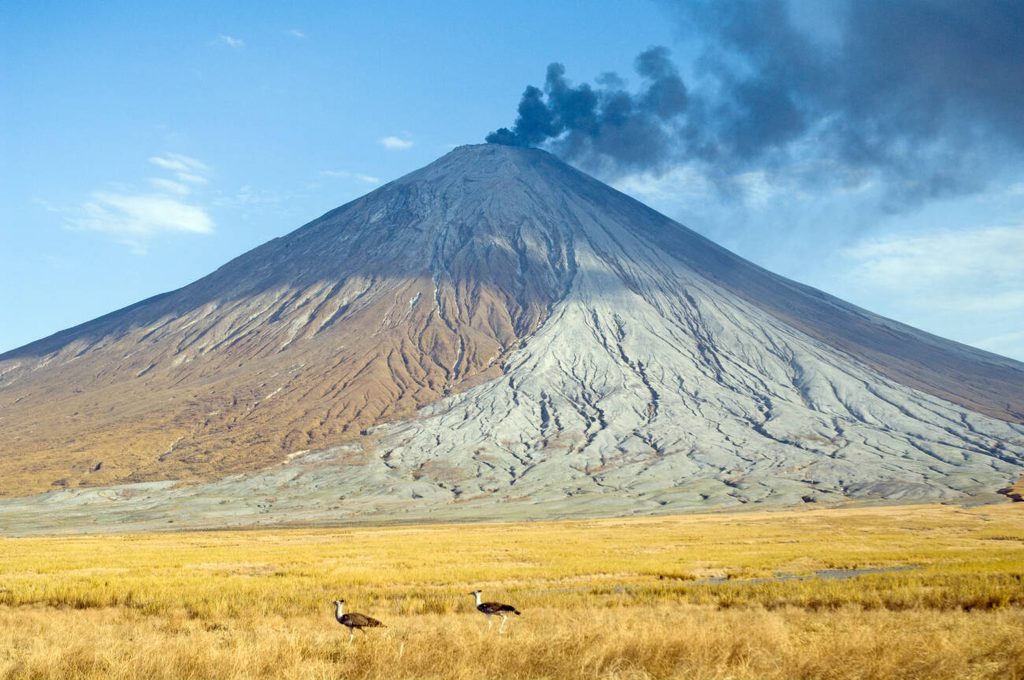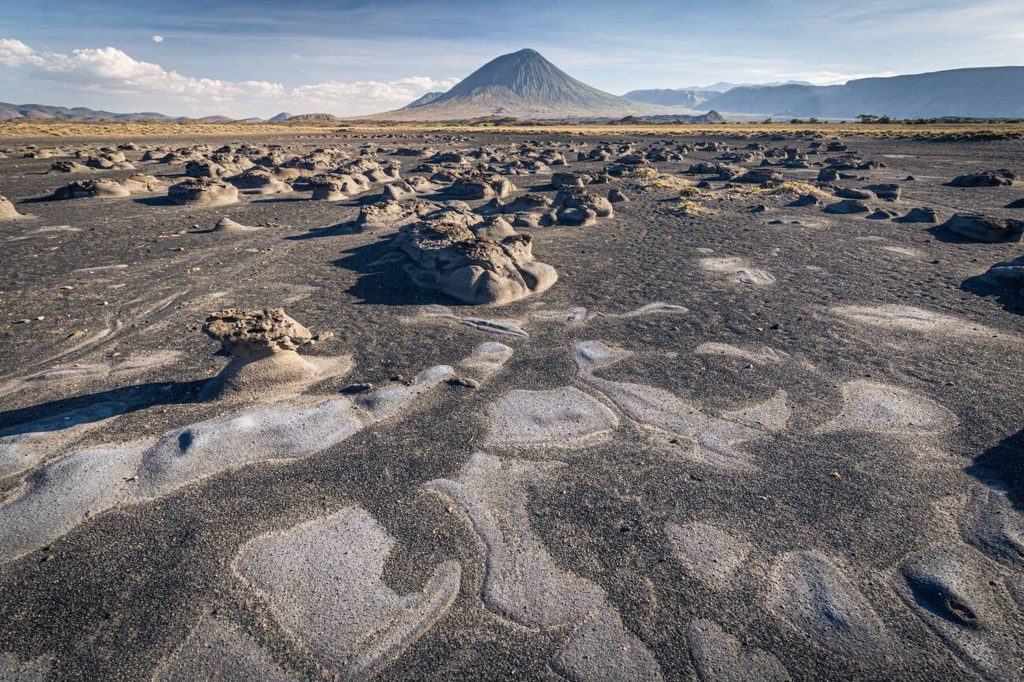Lake Natron (Flamingos)
Nestled in northern Tanzania’s Gregory Rift Valley, at the foot of the active Ol Doinyo Lengai volcano, Lake Natron is a striking soda lake known for its extreme conditions and surreal beauty. Despite its shallow depth, the lake stretches 57 km long and 22 km wide, with water temperatures often exceeding 40°C. Its alkaline waters (pH >12) create a unique ecosystem where salt-loving microorganisms thrive, giving the lake its signature red and pink hues.
This harsh yet fascinating environment supports flamingos, cyanobacteria, and rare halophilic life, making it a paradise for birdwatchers, photographers, and nature lovers. Visitors can also experience waterfall hikes, Maasai cultural encounters, and the challenge of trekking Ol Doinyo Lengai, ensuring an unforgettable adventure in one of Africa’s most otherworldly landscapes.

Flamingos in Lake Natron.
Lake Natron, a saline, alkaline lake in Tanzania, serves as a vital habitat for lesser and greater flamingos, each species with distinct characteristics. The lesser flamingo is smaller, standing around 80–90 cm tall, with a slender neck and beak, perfectly suited for feeding on blue-green algae in the highly alkaline waters.
These flamingos thrive in the lake’s shallow, saline conditions, where they form massive colonies that paint the shores pink. In contrast, the greater flamingo is larger, reaching up to 150 cm in height, with a taller, more robust neck and a longer, straighter bill, adapted for filtering out invertebrates from the mudflats and less saline areas. Greater flamingos are less abundant at Lake Natron, typically found in smaller groups near the lake’s edges or surrounding wetlands. While both species breed at Lake Natron, the lesser flamingo is more closely associated with the lake’s unique ecosystem, whereas the greater flamingo prefers less extreme salinity levels.

Activities to do in Lake Natron.
- Hiking to Ngare Sero Waterfalls
- Ol Doinyo Lengai Trekking
- Birdwatching & Photography
- Sunrise & Sunset Views
- Flamingo Watching
- Cultural Visits
- Lake Walks

Climate.
Lake Natron, located in northern Tanzania near the Kenyan border, has an arid and semi-arid climate characterized by high temperatures, low rainfall, and high evaporation rates. Here are the key climate features of the region:
- Temperature:
- Extremely hot, reaching 40°C (104°F) during the day, with nights rarely below 20°C (68°F).
- Rainfall:
- Low annual rainfall (500–800 mm), mostly in November–December and March–May.
- Humidity & Evaporation:
- Low humidity, with intense evaporation making the lake highly alkaline and saline.
- Winds:
- Strong, hot winds speed up evaporation and shape the arid landscape.
- Seasons:
- Dry Season (June–October): Hot, dry, and dusty.
- Wet Season (November–May): Slightly cooler, with occasional rains.
This harsh climate sustains extremophile life, including thousands of flamingos and salt-loving microorganisms.

Best Time to Visit.
Lake Natron is a year-round destination, but the best time to visit depends on your interests. Due to dry roads, the dry season (June–October) offers clear skies, excellent flamingo sightings, and easier access. The wet season (November–May) brings dramatic landscapes, occasional rains, and lush surroundings, though some areas may become muddy and less accessible. For birdwatching, September to December is ideal when flamingos nest in large numbers. Regardless of the season, Lake Natron’s unique ecosystem and stunning scenery make it a captivating destination any time of the year.
How to Get to Lake Natron
- By Road:
- From Arusha (6–7 hrs) or Ngorongoro/Serengeti (5–6 hrs) via rough, dusty roads—4×4 required.
- By Air:
- Fly to Lake Manyara or Klein’s Camp Airstrip, then take a 4×4 transfer.
A challenging journey, but the surreal landscapes make it worth every mile!
Facts About Lake Natron.
- The lake is 57 kilometers long and 22 kilometers wide.
- The alkalinity of the lake can reach a pH level of more than 12
- The temperatures at the lake are often over 40 ° C.
- Special bacteria and blue algae create a rich breeding ground for birdlife.
The Story of the Sacred Volcano with Spiritual Significance.
Ol Doinyo Lengai, the “Mountain of God”, stands as a sacred symbol in northern Tanzania, revered by the Maasai people as the dwelling place of their creator god, Enkai. Towering at nearly 3,000 meters, this active volcano is not just a natural wonder but a powerful spiritual force.
The Maasai view its eruptions as divine manifestations, with each rumble of the earth signaling messages from the gods. Known for its unique natrocarbonatite lava, which flows smoothly like liquid, Ol Doinyo Lengai is a sacred pilgrimage site for Maasai warriors, offering both a physical challenge and spiritual renewal.
The most recent eruption occurred in 2019, sending plumes of ash and lava down its slopes, further reinforcing its divine connection. While not the highest peak in Tanzania, Ol Doinyo Lengai presents a greater challenge than Kilimanjaro and Mount Meru due to its steep slopes, volcanic terrain, and highly volatile conditions.
For visitors, the mountain is a breathtaking symbol of nature’s power, intricately tied to the culture, spirituality, and enduring traditions of the Maasai people.














